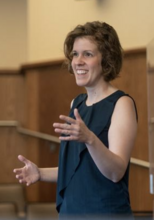Laura E. Thomas, Ph.D.

Associate Professor
Department of Psychology
North Dakota State University
Office: 126C14 Minard Hall
Email: laura.e.thomas@ndsu.edu
Research Interests
My research investigates the ways in which actions influence perception and cognition. The actions we perform—and our potential to interact with the environment—shape our thought processes, reflecting perception and cognition's sensitivity to behavioral contexts. I incorporate approaches from vision science and grounded cognition to study the ways in which action and affordances affect perception and key components of cognition such as problem solving, memory, and attention. By examining when and why actions influence processing, my goal is to enhance our understanding of the mechanisms and representations that tie perception, cognition, and action together.
Work in the Action and Cognition Lab has been funded by grants from the National Science Foundation, National Institutes of Health, Google, and the NDSU Center for Immunization Research and Education.
I currently serve as an Associate Editor at Memory & Cognition and Journal of Experimental Psychology: General.
Education
Ph.D., 2008, Psychology, University of Illinois at Urbana-Champaign
B.A., 2002, Psychology (summa cum laude), Washington University in St. Louis
Academic Appointments
2018-Present, Associate Professor, Department of Psychology, North Dakota State University
2011-2018, Assistant Professor, Department of Psychology, North Dakota State University
2008-2011, Postdoctoral Fellow, Perception, Attention, and Control Lab, Vanderbilt University
Courses Taught
PSYC 350: Research Methods I
PSYC 464/664: Attention and Thinking
PSYC 764: Advanced Topics in Attention
PSYC 763: Grant Writing for Psychological Scientists
Selected Publications
Laura E. Thomas - Google Scholar
McManus, R., & Thomas, L. E. (2020). Vision is biased near hand-held, but not remotely operated, tools. Attention, Perception, & Psychophysics, 82, 4038-4057.
Agauas, S. J., Jacoby, M., & Thomas, L. E (2020). Near-hand effects are robust: Three OSF pre-registered replications of visual biases in perihand space. Visual Cognition, 192-204.
Agauas, S. J., & Thomas, L. E. (2019). Change detection for real world objects in perihand space. Attention, Perception, & Psychophysics, 81, 2365-2383.
Thomas, L. E. (2017). Action experience drives visual processing biases near the hands. Psychological Science, 28, 124-131.
Balas, B., & Thomas, L. E. (2015). Competition makes observers remember faces as more aggressive. Journal of Experimental Psychology: General, 144(4), 711-716.
Thomas, L. E. (2015). Grasp posture alters visual processing biases near the hands. Psychological Science, 26(5), 625-632.
Thomas, L. E., & Pemstein, D. (2015). What you see is what you get: Webcame placement influences perception and social coordination. Frontiers in Psychology, 6:306.
Thomas, L. E., Davoli, C. C., & Brockmole, J. R. (2014). Competitive interaction leads to perceptual distancing between actors. Journal of Experimental Psychology: Human Perception and Performance, 40, 2112-2116.
Kuylen, C., Balas, B., & Thomas, L. E. (2014). My shadow, myself: Cast-body shadows are embodied. Psychonomic Bulletin & Review, 21, 676-681.
Sun, H. M., & Thomas, L. E. (2013). Biased attention near another's hand following joint action. Frontiers in Psychology, 4:443.
Thomas, L. E. (2013). Spatial working memory is necessary for actions to guide thought. Journal of Experimental Psychology: Learning, Memory, and Cognition, 39, 1974-1981.
Thomas, L. E., Davoli, C. C., & Brockmole, J. R. (2013). Interacting with objects compresses environmental representations in spatial memory. Psychonomic Bulletin & Review, 20, 101-107.
Thomas, L. E., & Seiffert, A. E. (2010). Self-motion impairs multiple-object tracking. Cognition, 177, 80-86.
Thomas, L. E., & Lleras, A. (2007). Moving eyes and moving thought: On the spatial compatibility between eye movements and cognition. Psychonomic Bulletin & Review, 14, 663-668.
This Web page represents the views of the author and not necessarily those of North Dakota State University.
NDSU is not responsible or liable for its contents.
